HDMI cable vs. DisplayPort is a popular interface for transmitting audio and video signals. Whether you’re a gamer, film buff, or love your multimedia devices, you’ve most likely been in a situation where you had to choose one of these two.
While it may not be apparent which one is better by looking at them, HDMI has proven to be the king of compatibility. They are both physically robust, easy to connect, and compatible with various devices.
They have their differences, making them suitable for different use cases.
But what are these interfaces? And which one should you choose?
Table of Contents
- What Are HDMI and DisplayPort Cables?
- HDMI Cable vs. DisplayPort: Key Differences and Specifications
- HDMI Cable vs. DisplayPort: Which One Should I Use?
- Conclusion
What Are HDMI and DisplayPort Cables?
HDMI
An HDMI cable transmits video and audio signals from a source (such as a computer, Blu-ray player, or gaming console) to a display device.
It uses a standard 19-pin connector. They can transmit uncompressed digital video and audio signals in high-definition (HD) and ultra-high-definition (UHD) resolutions.
They are 5 types of HDMI different connectors:
- Type A (Full-size)
- Type B (Dual-link)
- Type C (Mini)
- Type D (Micro)
- Type E (Automotive)
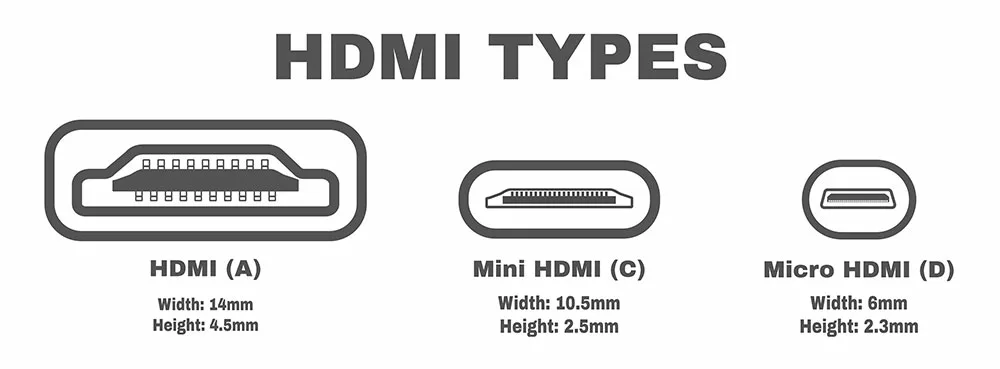
HDMI cable input types and plug sizes.
The Standard (Full-size), Mini, and Micro are used in computer display units and are the ones you’ve probably interacted with.
DisplayPort
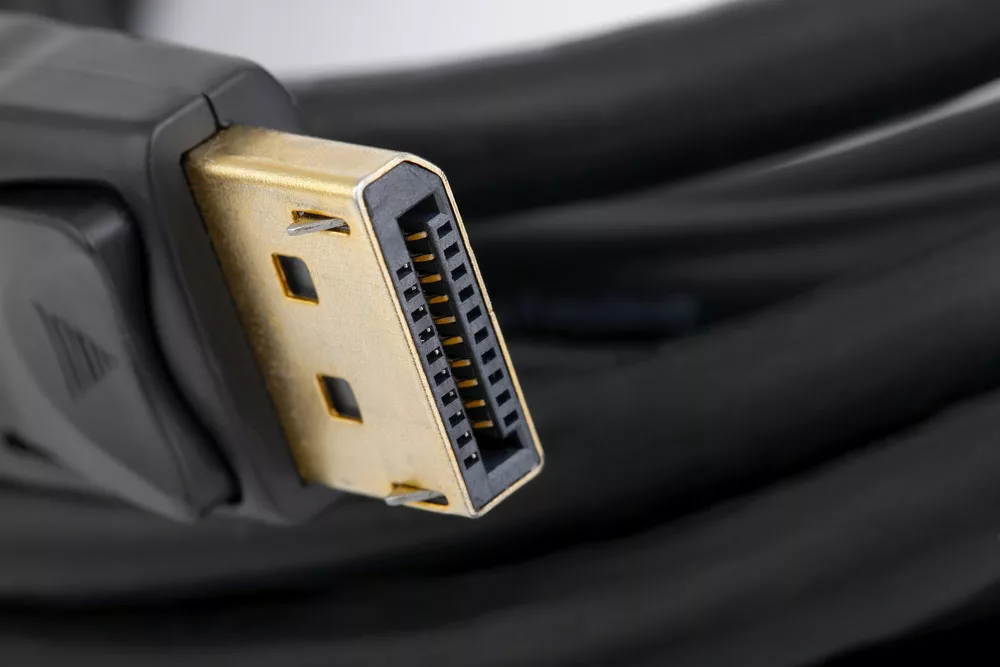
Gold-plated DisplayPort connector.
On the flip side, DisplayPort connectors have either 20 or 32 pins, depending on the version of DisplayPort. Video Electronics Standards Association (VESA) came up with DisplayPort cables as a replacement for the VGA, DVI, and LVDS cables.
They can transmit uncompressed video, audio, and other data, such as USB signals.
DisplayPort also supports Adaptive Sync technology, which synchronizes the display’s refresh rate with the output device’s frame rate. This serves to reduce screen tearing and stuttering.
HDMI Cable vs. DisplayPort: Key Differences and Specifications

An HDMI and DisplayPort cable on a surface.
Let’s look at some specifications and features that may help you choose the perfect one for your needs.
Specifications (Resolution, Bandwidth, Refresh rate, Audio)
DisplayPort is the clear winner in this category. But, you have to recognize that different cables have different capabilities owing to their different version revisions.
This compilation is as of 2023.
HDMI
Here are some HDMI specifications:
- Audio: HDMI supports up to 32 audio channels and can deliver high-quality audio at up to 1536 kHz sample rate. It also supports several audio formats, including Dolby Digital, DTS, and Dolby Atmos.
- HDR: HDMI supports HDR (High Dynamic Range) for improved color and contrast.
- Cable Length: HDMI cables have a length limitation of 15 meters for standard HDMI cables and up to 100 meters for HDMI fiber optic cables.
- Bandwidth: HDMI cables have a capacity ranging from 4.95 to 48 Gbps, depending on the version of HDMI.
For reference with refresh rate and resolution, check out the table below.
| Specification | Version Year | Maximum Resolution | More |
| HDMI 1.0 | 2002 | 1980 x1080 @ 60Hz | |
| HDMI 1.1–1.2a | 2004–2005 | 1980 x1080 @ 60Hz | |
| HDMI 1.3–1.3c | 2006–2008 | 2560×1440 @ 30Hz | Dolby TrueHD DTS-HD |
| HDMI 1.4–1.4b | 2009–2011 | 3840×2160 @ 30Hz 4096×2160 @ 24Hz | 2K @ 120Hz 4K @ 30Hz Ethernet over HDMI |
| HDMI 2.0–2.0b | 2013–2016 | 4096×2160 @ 60Hz | 2K @ 240Hz 4K@ 60Hz |
| HDMI 2.1–2.1a | 2017–2022 | 7680×4320 @ 60Hz | 8K @ 60Hz 4K @ 120Hz |
Disclaimer: An archive of HDMI standards is not publicly available at HDMI.com or elsewhere online. As such, conflicting indications exist for the highest available resolutions published elsewhere.
For example, some sources state that HDMI 1.0 can support 1920×1200 @ 60Hz. However, you should note that some HDMI specifications can support higher refresh rates by using 4:2:0 encoding.
DisplayPort
As the DisplayPort standard advances, it requires greater bandwidth to support higher video color depths, resolutions, and refresh rates.
DP 1.3 and 1.4 offer an effective data rate that can handle a 4K, 24-bit color monitor at a refresh rate of up to 120 Hz. But compression is necessary to support the latest generation of high-resolution 6K and 8K displays.
| Specification | Year | Maximum Resolution | Bandwidth |
| DP 1.0 | 2006 | 1440p @ 60 Hz | ~ 5/8.64 Gbps |
| DP 1.1 | 2007 | 1440p @ 60 Hz | ~ 8.64 Gbps |
| DP 1.2 | 2009 | 4K @ 60 Hz | ~ 21.6 Gbps |
| DP 1.3 | 2014 | 4K @ 120 Hz 8K @ 60 Hz | ~ 25.92 Gbps |
| DP 1.4 | 2016 | 4K @ 120 Hz 8K @ 60 Hz | ~ 25.92 Gbps |
| DP 1.4a | 2018 | 4K @ 120 Hz 8K @ 60 Hz | ~ 25.92 Gbps |
| DP 2.0 | 2019 | 8K @ 60 Hz | ~ 77.36 Gbps |
| DP 2.1 | 2022 | 8K @ 60 Hz | ~ 77.36 Gbps |
Multi-Display Feature
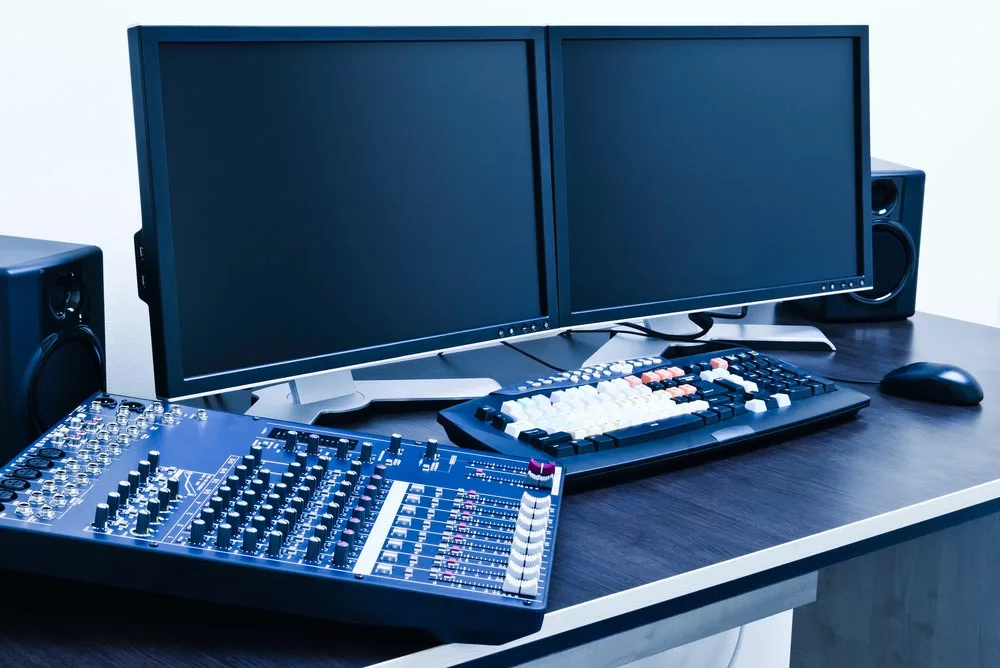
Professional editing station with audion mixer and dual monitor setup.
Both DisplayPort and HDMI support multi-display setups. But, there are some differences in how they handle this feature.
DisplayPort
It supports multi-display setups, which lets you daisy chain up to four monitors to a single DisplayPort output.
DisplayPort also supports multi-stream transport (MST), allowing you to create a single large display using multiple monitors.
DisplayPort 1.4a Multi-Stream Transport allows you to daisy chain up to two 4K displays or four 1080p displays from a single DisplayPort 1.4 output.
Though you’d have to worry about the shared bandwidth affecting your output quality for some versions.
HDMI
HDMI also supports multi-display setups but is not as flexible as DisplayPort. HDMI 2.0 and later versions support multi-stream transport (MST).
However, unlike DisplayPort, HDMI does not support daisy-chaining multiple displays over one cable.
HDMI also limits the number of displays connected to a single output. HDMI 2.0 and earlier versions support a maximum of two displays, while HDMI 2.1 supports up to three.
HDMI Cable vs. DisplayPort: Compatibility
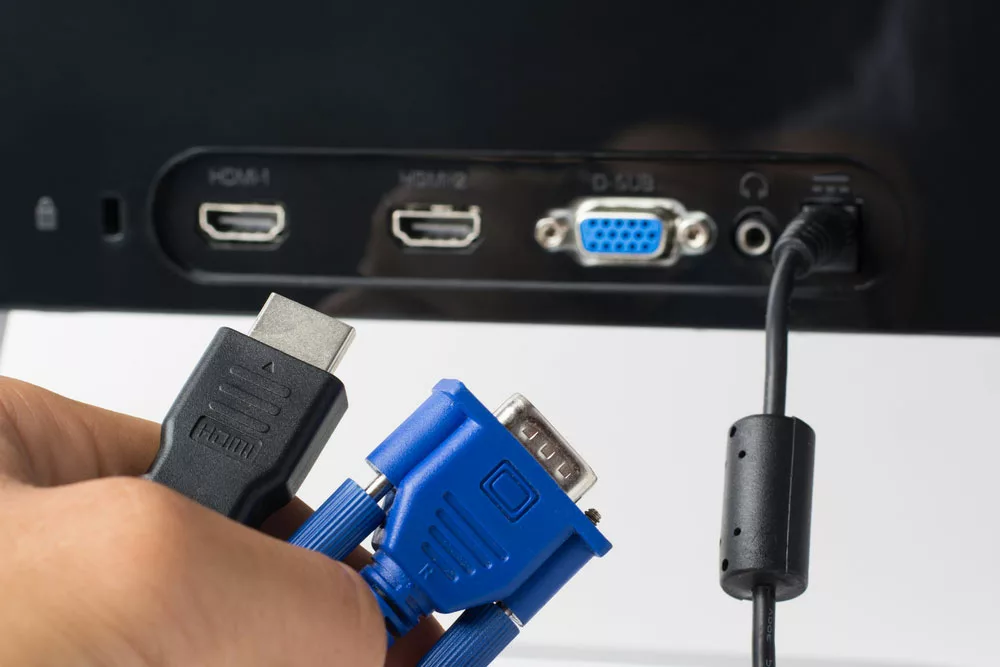
A hand holding an HDMI cable and a VGA cable.
It’s worth noting that devices more widely support HDMI compared to DisplayPort. HDMI will likely be the only option if you’re connecting a source device to a TV.
While higher-end monitors typically support both interfaces, budget monitors often only offer HDMI.
However, some Apple monitors only support DisplayPort—a move we are not so shocked to see.
For gamers, both HDMI and DisplayPort offer Variable Refresh Rate (VRR) support, which means the display’s refresh rate adjusts to match the frame rate of the source device.
This helps prevent screen tearing. NVidia G-SYNC, a technology that minimizes screen tearing, requires HDMI 2.1.
It’s important to note that the version of HDMI or DisplayPort used can affect the availability of certain features such as HDR. We recommend you always check the specifications of your devices before purchasing or connecting them.
HDMI Cable vs. DisplayPort: Hook-Up Adapters
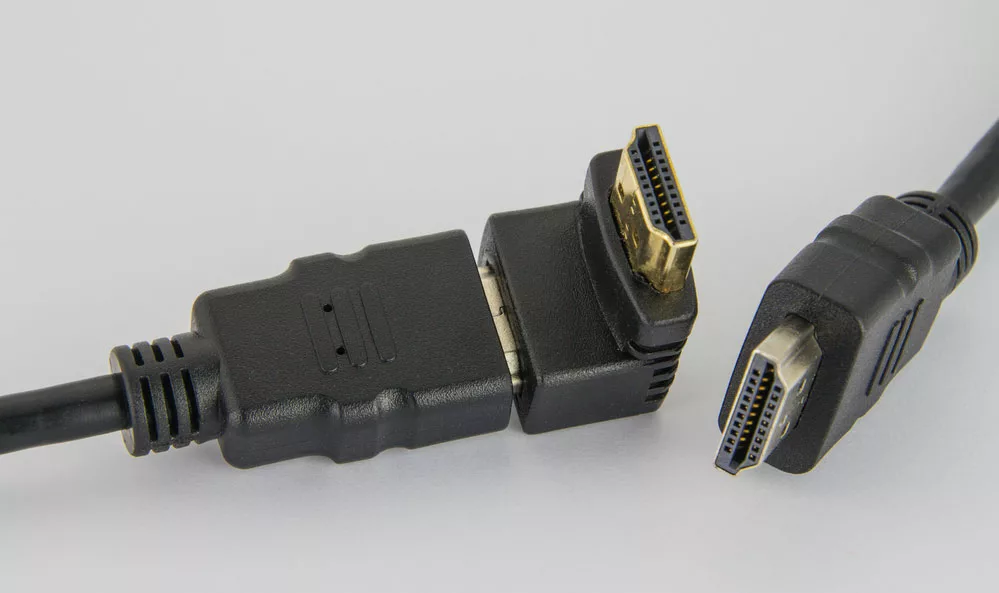
An HDMI cable with a 90-270 degree adapter.
Adapters are used to connect devices with different interfaces. When using an adapter, you need to choose an adapter compatible with the version of DisplayPort and HDMI that your devices support.
If your HDMI to DisplayPort cable is not working, you should check if your device supports it first. Otherwise, it’s loose or broken.
Note that using a standard dongle adapter denies you the ability to daisy chain multiple displays.
Will a DisplayPort-to-HDMI Adapter Run 144 Hz?
The refresh rate and resolution that a DisplayPort-to-HDMI adapter can support will depend on the bandwidth limitations of both the adapter and the connected devices.
For example, HDMI 1.4 can only support a maximum refresh rate of 120 Hz at 1080p resolution, while HDMI 2.0 can support 144 Hz at 1080p and up to 60 Hz at 4K resolution.
Similarly, DisplayPort 1.2 can support a maximum refresh rate of 144 Hz at 1080p and up to 60 Hz at 4K resolution, while DisplayPort 1.4 can support up to 240 Hz at 1080p and up to 120 Hz at 4K resolution.
HDMI Cable vs. DisplayPort: Which One Should I Use?

Various video interface cables are held in one hand.
For power users, DisplayPort is a better choice for high-end gaming or video editing due to its support for higher refresh rates, higher resolutions, and advanced features like daisy-chaining and adaptive sync technologies.
HDMI, on the other hand, is more suitable for home theater setups or everyday use cases, as TVs, gaming consoles, and other consumer devices widely support it.
HDMI also supports features like HDMI-CEC, which allows you to control multiple devices with a single remote. This is particularly helpful in a hall setup with multiple displays streaming the same content.
Conclusion
When choosing between DisplayPort and HDMI, you must consider your specific use case and the required features. DisplayPort may be the better for gaming or video editing, while HDMI is a good option for home theater setups or everyday use.
Check the specifications of your devices and cables to ensure compatibility and optimal performance.
